Gene Regulatory Network Analysis of Post-Mortem Lungs Unveils Novel Insights into COVID-19 Pathogenesis
Abstract
:1. Introduction
2. Materials and Methods
2.1. Sample Collection
2.2. Total RNA Isolation
2.3. miRNA Microarray Analysis
2.4. NanoString’s nCounter® Host Reponse Panel
2.5. NanoString’s nCounter XT Gene Expression Assay
2.6. Functional Enrichment Analysis
2.7. Statistical Analysis
3. Results
3.1. COVID-19 Patients and Control Demographics
3.2. miRNA Expression Alterations in Lung Biopsy Specimens of COVID-19 Patients
3.3. Perturbed mRNA Expression Profiles in COVID-19 Lung Biopsies
3.4. Differential Gene Expression and Pathway Enrichment of Host Cellular Responses to COVID-19 Infection in Lung
4. Discussion
5. Limitations
5.1. Limited Information on Lung Sample Location
5.2. Low Sample Size
5.3. Selection of Control Group
6. Conclusions
Supplementary Materials
Author Contributions
Funding
Institutional Review Board Statement
Informed Consent Statement
Data Availability Statement
Conflicts of Interest
References
- Vincent, J.-L.; Taccone, F.S. Understanding pathways to death in patients with COVID-19. Lancet Respir. Med. 2020, 8, 430–432. [Google Scholar] [CrossRef] [PubMed]
- Fine, D.H.; Mendieta, C.; Barnett, M.L.; Furgang, D.; Meyers, R.; Olshan, A.; Vincent, J. Efficacy of preprocedural rinsing with an antiseptic in reducing viable bacteria in dental aerosols. J. Periodontol. 1992, 63, 821–824. [Google Scholar] [CrossRef] [PubMed]
- Dorward, D.A.; Russell, C.D.; Um, I.H.; Elshani, M.; Armstrong, S.D.; Penrice-Randal, R.; Lucas, C.D. Tissue-specific immunopathology in fatal COVID-19. Am. J. Respir. Crit. Care Med. 2021, 203, 192–201. [Google Scholar] [CrossRef] [PubMed]
- Pandey, P.; Agarwal, S. Lung pathology in COVID-19: A systematic review. Int. J. Appl. Basic Med. Res. 2020, 10, 226. [Google Scholar] [CrossRef] [PubMed]
- Banerjee, A.; El-Sayes, N.; Budylowski, P.; Jacob, R.A.; Richard, D.; Maan, H.; Mossman, K. Experimental and natural evidence of SARS-CoV-2-infection-induced activation of type I interferon responses. IScience 2021, 24, 102477. [Google Scholar] [CrossRef] [PubMed]
- Kawai, T.; Akira, S. Innate immune recognition of viral infection. Nat. Immunol. 2006, 7, 131–137. [Google Scholar] [CrossRef] [PubMed]
- de Paula, C.B.V.; de Azevedo, M.L.V.; Nagashima, S.; Martins, A.P.C.; Malaquias, M.A.S.; Miggiolaro, A.F.R.d.S.; Júnior, J.d.S.M.; Avelino, G.; Carmo, L.A.P.D.; Carstens, L.B.; et al. IL-4/IL-13 remodeling pathway of COVID-19 lung injury. Sci. Rep. 2020, 10, 18689. [Google Scholar] [CrossRef] [PubMed]
- Su, C.-M.; Wang, W.; Yoo, D. Activation of NF-κB and induction of proinflammatory cytokine expressions mediated by ORF7a protein of SARS-CoV-2. Sci. Rep. 2021, 11, 13464. [Google Scholar] [CrossRef]
- Rincon-Arevalo, H.; Aue, A.; Ritter, J.; Szelinski, F.; Khadzhynov, D.; Zickler, D.; Stefanski, L.; Lino, A.C.; Körper, S.; Eckardt, K.; et al. Altered increase in STAT1 expression and phosphorylation in severe COVID-19. Eur. J. Immunol. 2022, 52, 138–148. [Google Scholar] [CrossRef]
- Delorey, T.M.; Ziegler, C.G.K.; Heimberg, G.; Normand, R.; Yang, Y.; Segerstolpe, A.; Abbondanza, D.; Fleming, S.J.; Subramanian, A.; Montoro, D.T.; et al. COVID-19 tissue atlases reveal SARS-CoV-2 pathology and cellular targets. Nature 2021, 595, 107–113. [Google Scholar] [CrossRef]
- Nemecz, M.; Alexandru, N.; Tanko, G.; Georgescu, A. Role of microRNA in endothelial dysfunction and hypertension. Curr. Hypertens. Rep. 2016, 18, 87. [Google Scholar] [CrossRef] [PubMed]
- Bruscella, P.; Bottini, S.; Baudesson, C.; Pawlotsky, J.-M.; Feray, C.; Trabucchi, M. Viruses and miRNAs: More friends than foes. Front. Microbiol. 2017, 8, 824. [Google Scholar] [CrossRef] [PubMed]
- Stolzenburg, L.R.; Harris, A. The role of microRNAs in chronic respiratory disease: Recent insights. Biol. Chem. 2018, 399, 219–234. [Google Scholar] [CrossRef] [PubMed]
- Bartoszewski, R.; Dabrowski, M.; Jakiela, B.; Matalon, S.; Harrod, K.S.; Sanak, M.; Collawn, J.F. SARS-CoV-2 may regulate cellular responses through depletion of specific host miRNAs. Am. J. Physiol. -Lung Cell. Mol. Physiol. 2020, 319, L444–L455. [Google Scholar] [CrossRef] [PubMed]
- Khan, M.A.A.K.; Sany, M.R.U.; Islam, M.S.; Islam, A.B.M.M.K. Epigenetic regulator miRNA pattern differences among SARS-CoV, SARS-CoV-2, and SARS-CoV-2 world-wide isolates delineated the mystery behind the epic pathogenicity and distinct clinical characteristics of pandemic COVID-19. Front. Genet. 2020, 11, 765. [Google Scholar] [CrossRef] [PubMed]
- Tokar, T.; Pastrello, C.; Rossos, A.E.; Abovsky, M.; Hauschild, A.C.; Tsay, M.; Jurisica, I. mirDIP 4.1—Integrative database of human microRNA target predictions. Nucleic Acids Res. 2018, 46, D360–D370. [Google Scholar] [CrossRef] [PubMed]
- Li, H.; Liu, S.-M.; Yu, X.-H.; Tang, S.-L.; Tang, C.-K. Coronavirus disease 2019 (COVID-19): Current status and future perspectives. Int. J. Antimicrob. Agents 2020, 55, 105951. [Google Scholar] [CrossRef] [PubMed]
- Ahn, D.-G.; Shin, H.-J.; Kim, M.-H.; Lee, S.; Kim, H.-S.; Myoung, J.; Kim, B.-T.; Kim, S.-J. Current status of epidemiology, diagnosis, therapeutics, and vaccines for novel coronavirus disease 2019 (COVID-19). J. Microbiol. Biotechnol. 2020, 30, 313–324. [Google Scholar] [CrossRef]
- Kitamura, T.; Qian, B.-Z.; Pollard, J.W. Immune cell promotion of metastasis. Nat. Rev. Immunol. 2015, 15, 73–86. [Google Scholar] [CrossRef]
- Sims, J.T.; Krishnan, V.; Chang, C.-Y.; Engle, S.M. Characterization of the cytokine storm reflects hyperinflammatory endothelial dysfunction in COVID-19. J. Allergy Clin. Immunol. 2021, 147, 107–111. [Google Scholar] [CrossRef] [PubMed]
- Sawant, K.V.; Poluri, K.M.; Dutta, A.K.; Sepuru, K.M.; Troshkina, A.; Garofalo, R.P.; Rajarathnam, K. Chemokine CXCL1 mediated neutrophil recruitment: Role of glycosaminoglycan interactions. Sci. Rep. 2016, 6, 33123. [Google Scholar] [CrossRef] [PubMed]
- Ghosh, S.; Karin, M. Missing pieces in the NF-κB puzzle. Cell 2002, 109, S81–S96. [Google Scholar] [CrossRef] [PubMed]
- Gabay, C. Interleukin-6 and chronic inflammation. Arthritis Res. Ther. 2006, 8, S3. [Google Scholar] [CrossRef]
- Kawasaki, T.; Kawai, T. Toll-like receptor signaling pathways. Front. Immunol. 2014, 5, 461. [Google Scholar] [CrossRef] [PubMed]
- Khanmohammadi, S.; Rezaei, N. Role of Toll-like receptors in the pathogenesis of COVID-19. J. Med. Virol. 2021, 93, 2735–2739. [Google Scholar] [CrossRef] [PubMed]
- De Groot, N.G.; Bontrop, R.E. COVID-19 Pandemic: Is a Gender-Defined Dosage Effect Responsible for the High Mortality Rate among Males? Springer: Berlin/Heidelberg, Germany, 2020. [Google Scholar]
- Cao, X. ISG15 secretion exacerbates inflammation in SARS-CoV-2 infection. Nat. Immunol. 2021, 22, 1360–1362. [Google Scholar] [CrossRef] [PubMed]
- Hu, B.; Huang, S.; Yin, L. The cytokine storm and COVID-19. J. Med. Virol. 2021, 93, 250–256. [Google Scholar] [CrossRef] [PubMed]
- Roganović, J. Downregulation of microRNA-146a in diabetes, obesity and hypertension may contribute to severe COVID-19. Med. Hypotheses 2021, 146, 110448. [Google Scholar] [CrossRef]
- Martonik, D.; Parfieniuk-Kowerda, A.; Rogalska, M.; Flisiak, R. The role of Th17 response in COVID-19. Cells 2021, 10, 1550. [Google Scholar] [CrossRef]
- Parackova, Z.; Bloomfield, M.; Klocperk, A.; Sediva, A. Neutrophils mediate Th17 promotion in COVID-19 patients. J. Leucoc. Biol. 2021, 109, 73–76. [Google Scholar] [CrossRef] [PubMed]
- De Biasi, S.; Meschiari, M.; Gibellini, L.; Bellinazzi, C.; Borella, R.; Fidanza, L.; Gozzi, L.; Iannone, A.; Tartaro, D.L.; Mattioli, M.; et al. Marked T cell activation, senescence, exhaustion and skewing towards TH17 in patients with COVID-19 pneumonia. Nat. Commun. 2020, 11, 3434. [Google Scholar] [CrossRef]
- Nakayama, T.; Hirahara, K.; Onodera, A.; Endo, Y.; Hosokawa, H.; Shinoda, K.; Okamoto, Y. Th2 cells in health and disease. Annu. Rev. Immunol. 2017, 35, 53–84. [Google Scholar] [CrossRef] [PubMed]
- Zhang, Q.; Putheti, P.; Zhou, Q.; Liu, Q.; Gao, W. Structures and biological functions of IL-31 and IL-31 receptors. Cytokine Growth Factor Rev. 2008, 19, 347–356. [Google Scholar] [CrossRef] [PubMed]
- Yombo, D.J.; Odayar, V.; Gupta, N.; Jegga, A.G.; Madala, S.K. The Protective Effects of IL-31RA Deficiency During Bleomycin-Induced Pulmonary Fibrosis. Front. Immunol. 2021, 12, 645717. [Google Scholar] [CrossRef]
- Kumar, M.; Ahmad, T.; Sharma, A.; Mabalirajan, U.; Kulshreshtha, A.; Agrawal, A.; Ghosh, B. Let-7 microRNA–mediated regulation of IL-13 and allergic airway inflammation. J. Allergy Clin. Immunol. 2011, 128, 1077–1085.e10. [Google Scholar] [CrossRef]
- Donlan, A.N.; Sutherland, T.E.; Marie, C.; Preissner, S.; Bradley, B.T.; Carpenter, R.M.; Sturek, J.M.; Ma, J.Z.; Moreau, G.B.; Donowitz, J.R.; et al. IL-13 is a driver of COVID-19 severity. JCI Insight 2021, 6, e150107. [Google Scholar] [CrossRef]
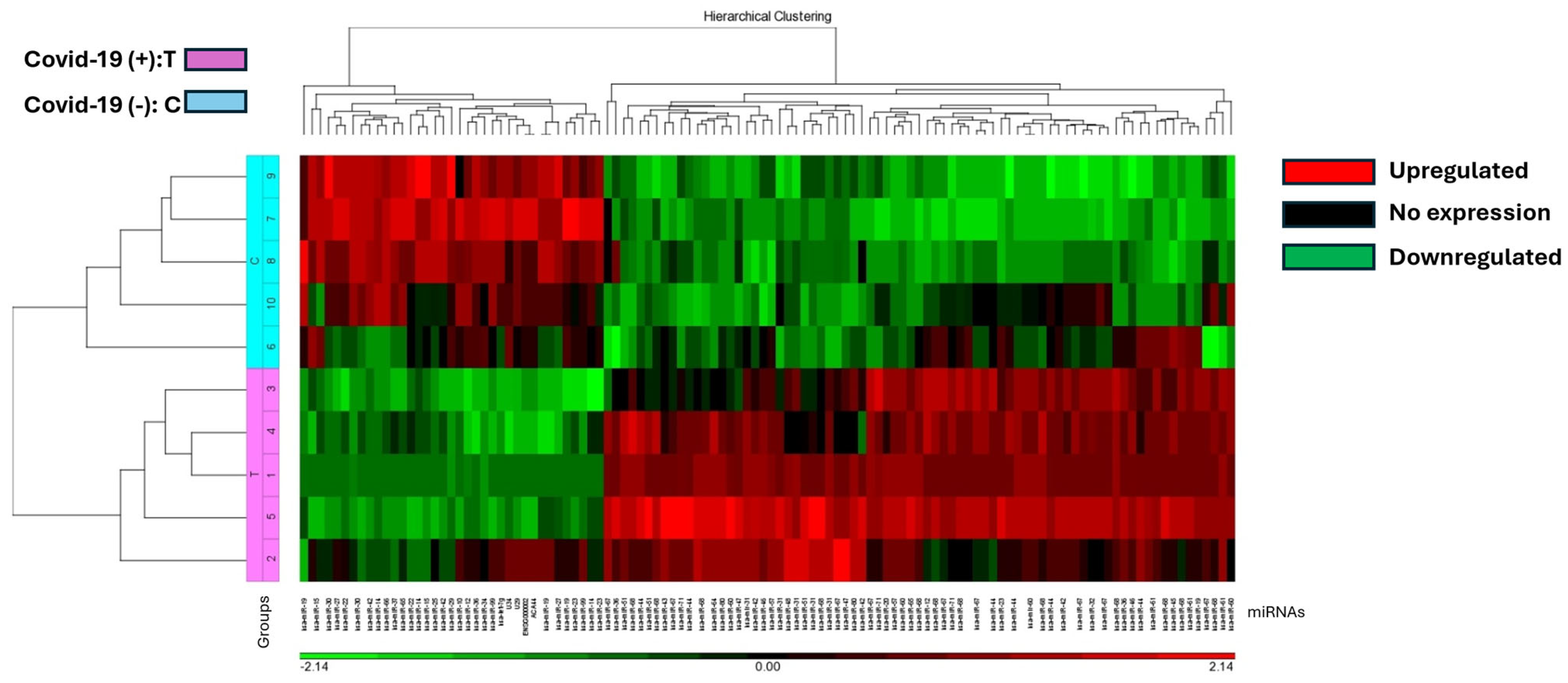
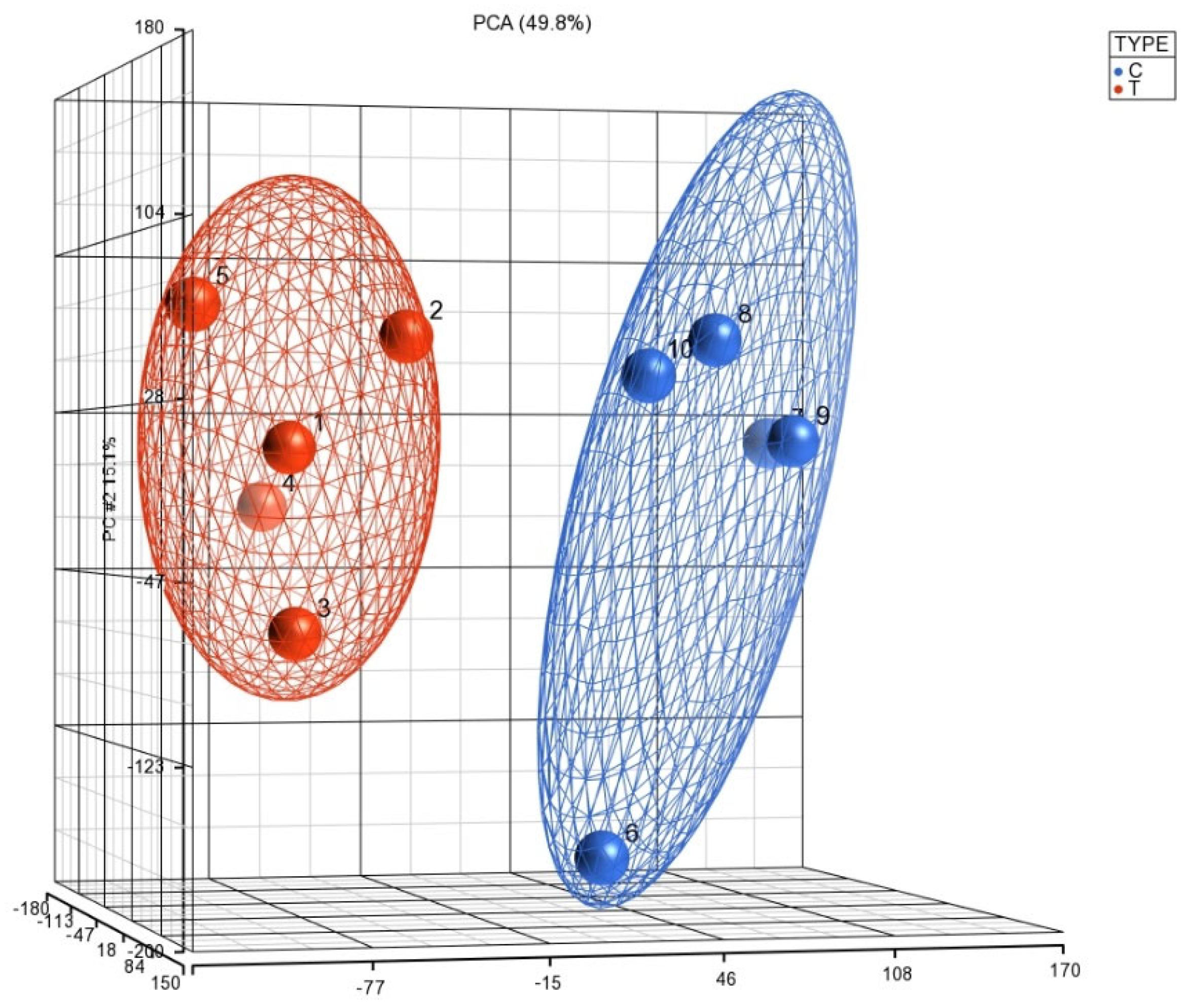
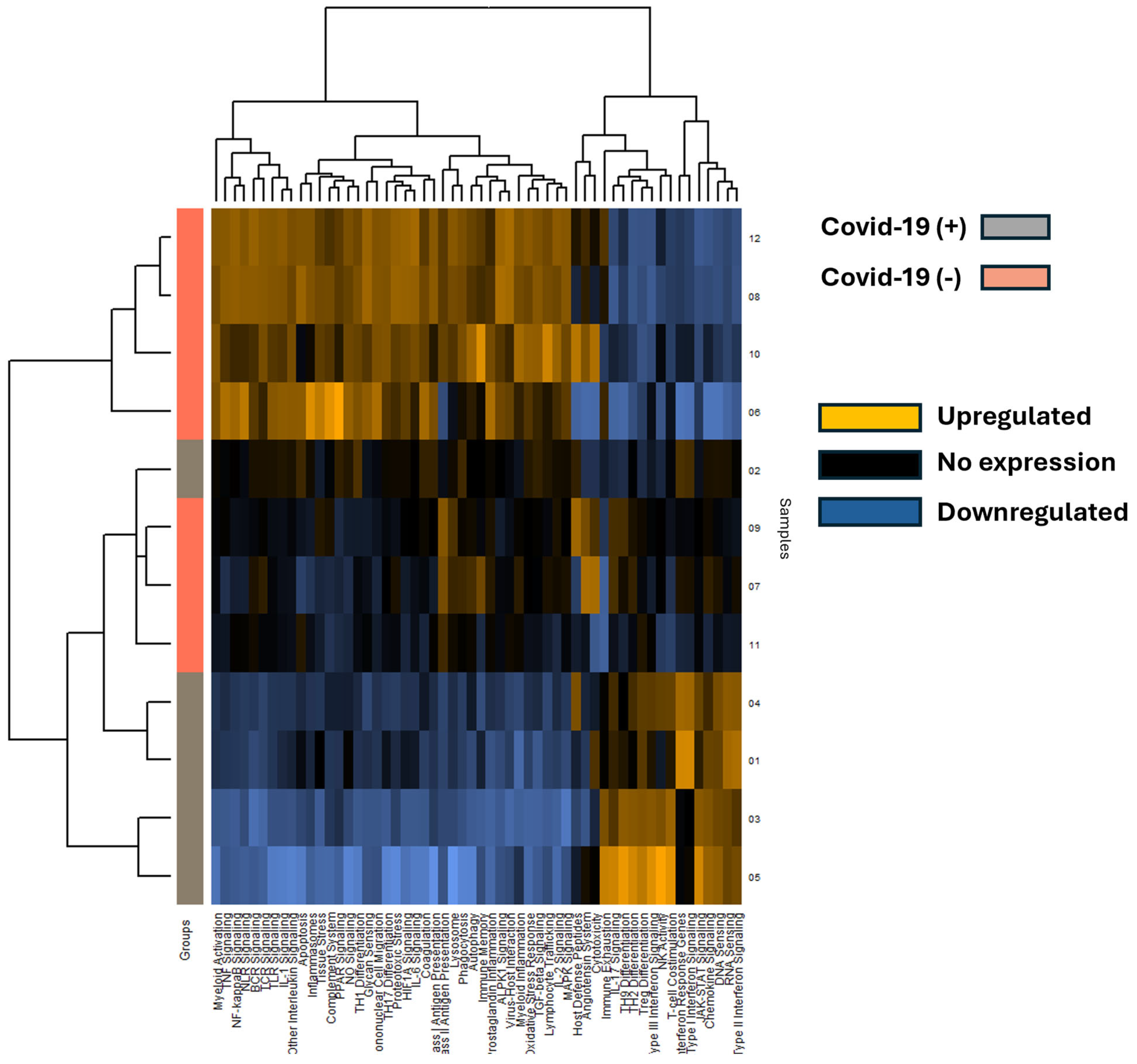
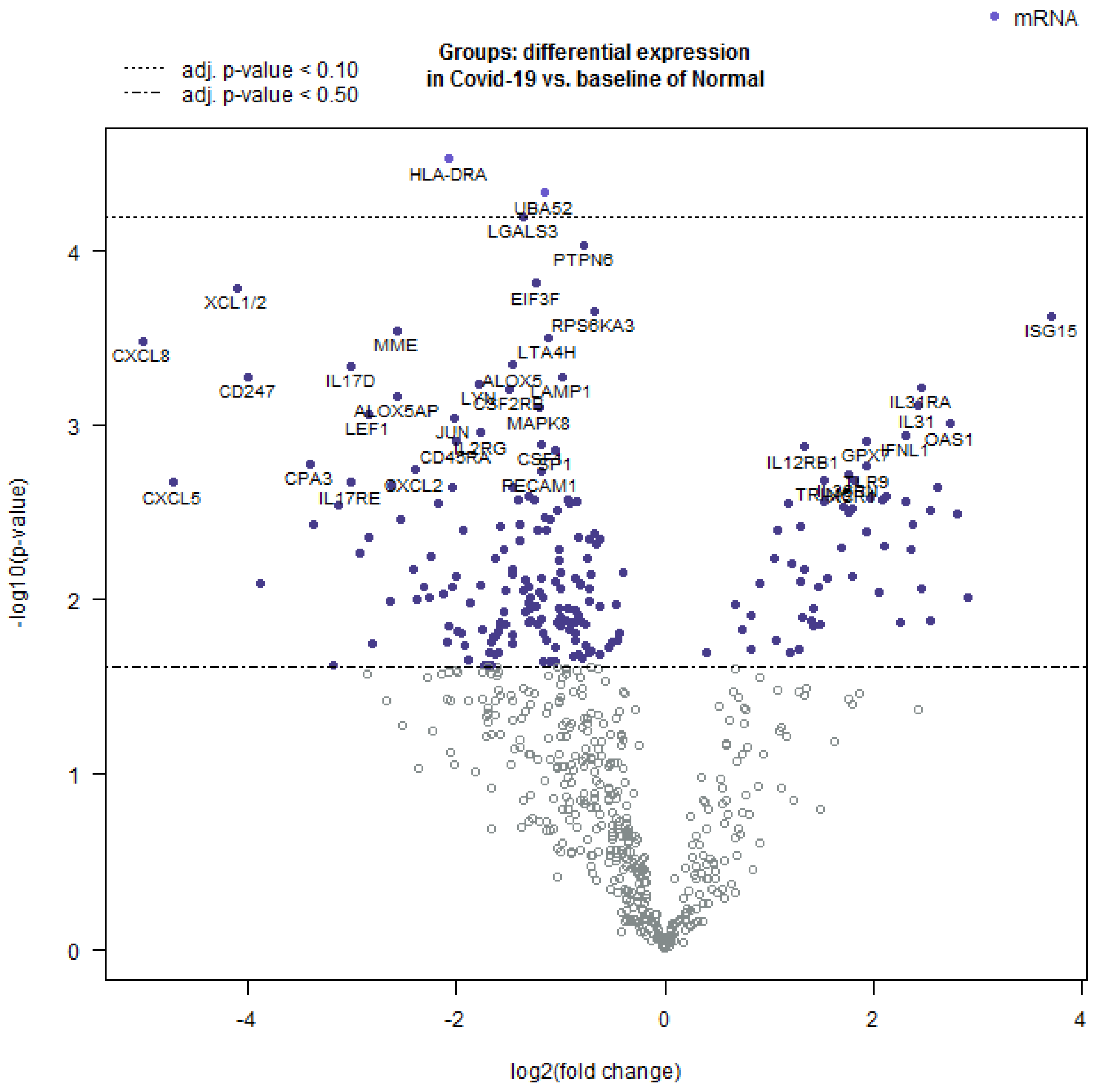
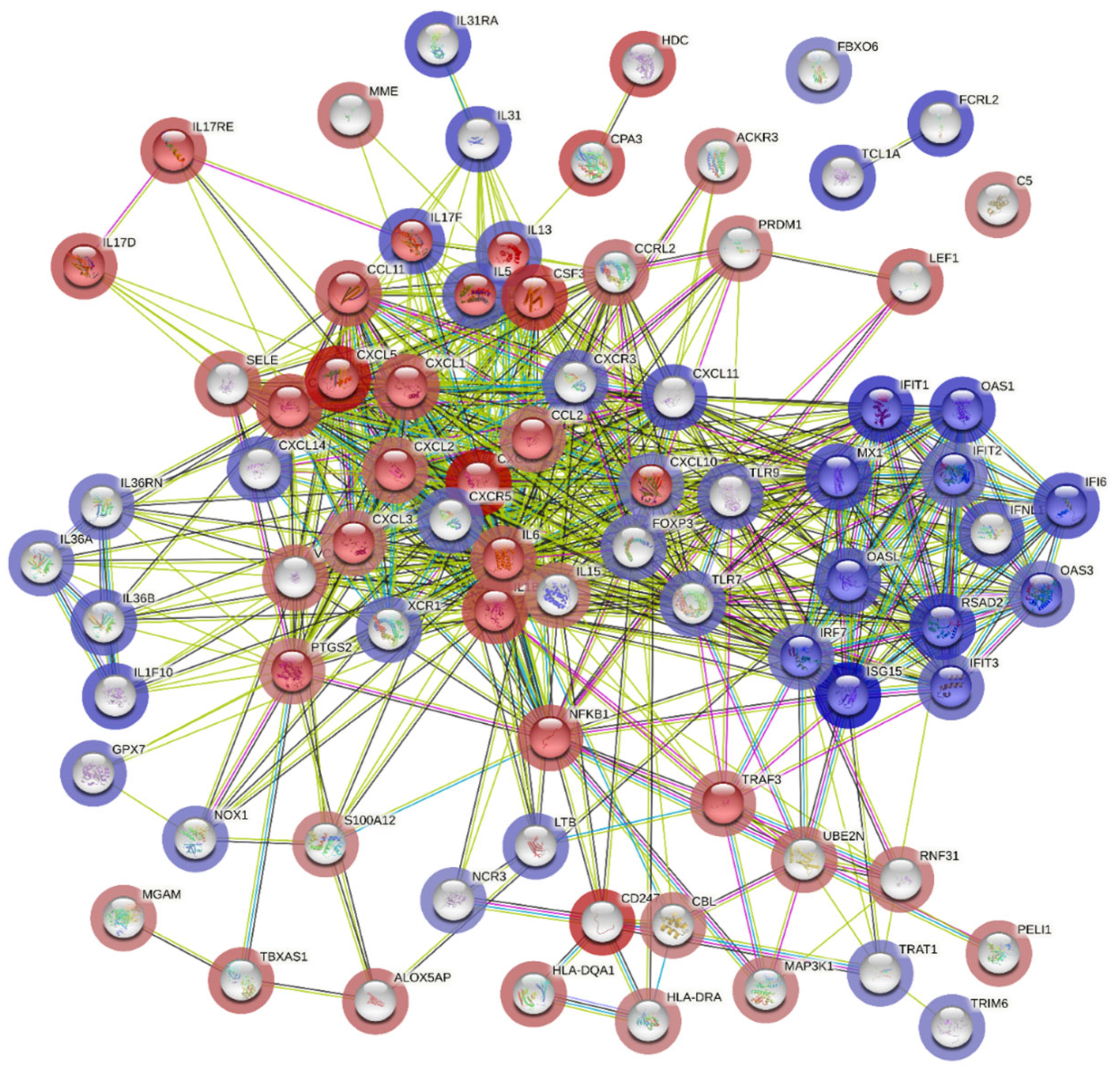
| No. | Disease Status | Date of Admission | Date of Death | Gender | AGE | Cause of Death |
|---|---|---|---|---|---|---|
| 1 | Covid + ve | 9/8/2020 | 9/18/2020 | MALE | 45 | COVID-19 Pulmonary injury |
| 2 | Covid + ve | 11/22/2020 | 11/24/2020 | MALE | 65 | COVID-19 Pneumonia |
| 3 | Covid + ve | 9/20/2020 | 10/4/2020 | MALE | 51 | COVID-19 Pneumonia |
| 4 | Covid + ve | 7/23/2020 | 7/25/2020 | FEMALE | 40 | COVID-19 Pneumonia |
| 5 | Covid + ve | 7/12/2020 | 8/10/2020 | MALE | 80 | COVID-19 Pneumonia |
| 6 | Covid − ve | 8/17/2020 | 8/24/2020 | MALE | 90 | Atherosclerotic cardiovascular disease |
| 7 | Covid − ve | 2/14/2021 | 2/15/2021 | MALE | 52 | Cerebrovascular accident secondary to hypertensive cardiovascular disease |
| 8 | Covid − ve | 2/15/2021 | 2/24/2021 | FEMALE | 72 | Atherosclerotic cardiovascular disease with diabetes mellitus and end-stage renal disease |
| 9 | Covid − ve | 3/25/2021 | 3/25/2021 | FEMALE | 100 | Hypertensive cardiovascular disease |
| 10 | Covid − ve | 2/15/2021 | 2/24/2021 | FEMALE | 72 | Atherosclerotic cardiovascular disease with diabetes mellitus and end-stage renal disease |
| 11 | Covid − ve | 4/13/2021 | 4/13/2021 | FEMALE | 54 | Cardiac arrhythmia due to cardiomegaly due to hypertension. Diabetes mellitus as a cofactor |
| 12 | Covid − ve | 9/13/2020 | 9/15/2020 | MALE | 33 | Midbrain hemorrhage due to hypertensive and atherosclerotic cardiovascular disease |
| mRNAs Involved | Log2 Fold Change | Std Error (log2) | Lower Confidence Limit (log2) | Upper Confidence Limit (log2) | p-Value | Gene Sets |
|---|---|---|---|---|---|---|
| CXCL8-mRNA | −5.01 | 0.94 | −6.85 | −3.17 | 0.000331 | Chemokine signaling, myeloid activation, NF-kappaB signaling, NLR signaling, RNA sensing, tissue stress, TLR signaling |
| CXCL5-mRNA | −4.72 | 1.15 | −6.97 | −2.47 | 0.00213 | Chemokine signaling, TNF signaling |
| XCL1/2-mRNA | −4.1 | 0.702 | −5.48 | −2.73 | 0.000163 | Chemokine signaling, mononuclear cell migration |
| CD247-mRNA | −4 | 0.798 | −5.56 | −2.44 | 0.000528 | NK activity, TCR signaling |
| CSF3-mRNA | −3.87 | 1.17 | −6.17 | −1.57 | 0.008 | JAK-STAT signaling, other interleukin signaling |
| CPA3-mRNA | −3.4 | 0.799 | −4.97 | −1.84 | 0.00167 | Angiotensin system |
| HDC-mRNA | −3.37 | 0.898 | −5.13 | −1.61 | 0.00374 | Myeloid inflammation |
| CCL20-mRNA | −3.18 | 1.19 | −5.52 | −0.84 | 0.0239 | Chemokine signaling, mononuclear cell migration, TNF signaling |
| IL1B-mRNA | −3.12 | 0.797 | −4.69 | −1.56 | 0.00287 | DNA sensing, glycan sensing, IL-1 signaling, inflammasomes, NF-kappaB signaling, NLR signaling, Th17 differentiation, TNF signaling |
| IL17RE-mRNA | −3.01 | 0.733 | −4.44 | −1.57 | 0.00214 | IL-17 signaling |
| IL17D-mRNA | −3 | 0.588 | −4.15 | −1.85 | 0.000458 | JAK-STAT signaling |
| CXCL1-mRNA | −2.92 | 0.828 | −4.54 | −1.3 | 0.00545 | Chemokine signaling, myeloid activation, NF-kappaB signaling, NLR signaling, TNF signaling |
| CCL11-mRNA | −2.85 | 1.1 | −5 | −0.69 | 0.0269 | Chemokine signaling, mononuclear cell migration |
| LEF1-mRNA | −2.84 | 0.607 | −4.03 | −1.65 | 0.000868 | TCR signaling |
| NFKB1-mRNA | −2.83 | 0.772 | −4.34 | −1.32 | 0.00433 | BCR signaling, DNA sensing, Glycan sensing, Inflammasomes, myeloid activation, NF-kappaB signaling, NLR signaling, RNA sensing, TCR signaling, Th1 differentiation, TLR signaling, TNF signaling, Type I interferon signaling |
| SELE-mRNA | −2.8 | 0.99 | −4.74 | −0.86 | 0.018 | Lymphocyte trafficking, TNF signaling |
| TBXAS1-mRNA | −2.66 | 1.11 | −4.85 | −0.48 | 0.0379 | Coagulation |
| IL6-mRNA | −2.64 | 0.835 | −4.28 | −1 | 0.0101 | DNA sensing, HIF1A signaling, IL-6 signaling, JAK-STAT signaling, mononuclear cell migration, myeloid activation, NLR signaling, Th17 differentiation, Th2 differentiation, tissue stress, TNF signaling |
| HLA-DQA-mRNA | −2.61 | 0.641 | −3.87 | −1.36 | 0.00223 | Lymphocyte trafficking, MHC Class II antigen presentation, phagocytosis, T cell costimulation, TCR signaling, type II interferon signaling |
| ALOX5AP-mRNA | −2.57 | 0.532 | −3.62 | −1.53 | 0.000687 | Leukotriene and prostaglandin inflammation, myeloid inflammation |
| CXCL14-mRNA | 2.06 | 0.639 | 0.806 | 3.31 | 0.00915 | Chemokine signaling |
| IL13-mRNA | 2.08 | 0.525 | 1.05 | 3.1 | 0.0027 | IL-1 signaling, JAK-STAT signaling, myeloid activation, myeloid inflammation, Th2 differentiation |
| IL5-mRNA | 2.1 | 0.585 | 0.957 | 3.25 | 0.00488 | IL-2 signaling, JAK-STAT signaling, TCR signaling, Th2 differentiation |
| IL36B-mRNA | 2.12 | 0.531 | 1.08 | 3.16 | 0.00253 | IL-1 signaling |
| OASL-mRNA | 2.25 | 0.753 | 0.775 | 3.73 | 0.0136 | Interferon response genes, type I interferon signaling, type II interferon signaling |
| IFNL1-mRNA | 2.3 | 0.511 | 1.3 | 3.3 | 0.00115 | JAK-STAT signaling, other interleukin signaling, type III interferon signaling |
| IL17F-mRNA | 2.3 | 0.583 | 1.16 | 3.45 | 0.00273 | IL-17 signaling, Th17 differentiation |
| IL1F10-mRNA | 2.36 | 0.664 | 1.06 | 3.66 | 0.00521 | IL-1 signaling |
| TCL1A-mRNA | 2.37 | 0.63 | 1.13 | 3.61 | 0.00372 | |
| IL31-mRNA | 2.42 | 0.51 | 1.42 | 3.42 | 0.00078 | IL-6 signaling |
| CXCL11-mRNA | 2.42 | 1.04 | 0.383 | 4.46 | 0.0422 | Chemokine signaling |
| IL31RA-mRNA | 2.46 | 0.501 | 1.48 | 3.45 | 0.000608 | IL-6 signaling, myeloid activation |
| IFI6-mRNA | 2.46 | 0.754 | 0.981 | 3.94 | 0.00857 | Type I interferon signaling |
| MX1-mRNA | 2.54 | 0.654 | 1.25 | 3.82 | 0.00307 | Interferon response genes, type I interferon signaling |
| FCRL2-mRNA | 2.54 | 0.847 | 0.884 | 4.2 | 0.0133 | |
| IFNA1/13-mRNA | 2.61 | 0.642 | 1.35 | 3.87 | 0.00228 | DNA sensing, JAK-STAT signaling, NLR signaling, RNA sensing, TLR signaling |
| OAS1-mRNA | 2.74 | 0.597 | 1.57 | 3.91 | 0.000984 | Interferon response genes, NLR signaling, type I interferon signaling, type II interferon signaling |
| RSAD2-mRNA | 2.8 | 0.727 | 1.37 | 4.22 | 0.00323 | type I interferon signaling |
| IFIT1-mRNA | 2.91 | 0.914 | 1.12 | 4.7 | 0.00979 | Interferon response genes, type I interferon signaling |
| ISG15-mRNA | 3.7 | 0.666 | 2.4 | 5.01 | 0.000239 | Interferon response genes, RNA sensing, type I interferon signaling |
| Pathways/Gene Sets Involved | Undirected Groups: Differential Expression in COVID-19 vs. Baseline of Normal | Directed Groups: Differential Expression in COVID-19 vs. Baseline of Normal |
|---|---|---|
| Type III Interferon Signaling | 2.469 | 2.081 |
| Interferon Response Genes | 2.876 | 1.654 |
| Type I Interferon Signaling | 2.743 | 0.54 |
| Immune Exhaustion | 1.794 | −0.737 |
| Treg Differentiation | 1.94 | −1.234 |
| Th9 Differentiation | 1.563 | −1.272 |
| MHC Class I Antigen Presentation | 1.964 | −1.406 |
| IL-6 Signaling | 2.866 | −1.414 |
| Type II Interferon Signaling | 2.735 | −1.446 |
| Th1 Differentiation | 2.328 | −1.498 |
| Host Defense Peptides | 1.52 | −1.52 |
| DNA Sensing | 2.481 | −1.523 |
| Other Interleukin Signaling | 2.218 | −1.539 |
| T-cell Costimulation | 2.46 | −1.545 |
| Th17 Differentiation | 2.619 | −1.684 |
| Th2 Differentiation | 2.826 | −1.693 |
| Oxidative Stress Response | 2.372 | −1.769 |
| JAK-STAT Signaling | 2.938 | −1.791 |
| NLR Signaling | 2.488 | −1.811 |
| NO Signaling | 1.908 | −1.828 |
| Proteotoxic Stress | 2.301 | −1.849 |
| IL-1 Signaling | 2.758 | −1.903 |
| Inflammasomes | 2.134 | −1.909 |
| NK Activity | 2.575 | −1.912 |
| Autophagy | 2.238 | −1.92 |
| Chemokine Signaling | 2.651 | −1.946 |
| Cytotoxicity | 1.983 | −1.974 |
| RNA Sensing | 2.974 | −1.982 |
| HIF1A Signaling | 2.208 | −1.994 |
| Myeloid Inflammation | 2.651 | −2.1 |
| Apoptosis | 2.144 | −2.103 |
| Complement System | 2.164 | −2.11 |
| Phagocytosis | 2.249 | −2.164 |
| NF-kappaB Signaling | 2.535 | −2.169 |
| Lymphocyte Trafficking | 2.325 | −2.224 |
| IL-17 Signaling | 2.841 | −2.225 |
| TLR Signaling | 2.706 | −2.225 |
| IL-2 Signaling | 2.679 | −2.255 |
| BCR Signaling | 2.636 | −2.293 |
| Glycan Sensing | 2.572 | −2.317 |
| Coagulation | 2.455 | −2.337 |
| Myeloid Activation | 2.594 | −2.393 |
| Lysosome | 2.503 | −2.41 |
| MAPK Signaling | 2.816 | −2.472 |
| Mononuclear Cell Migration | 2.613 | −2.478 |
| TCR Signaling | 2.836 | −2.495 |
| TNF Signaling | 2.691 | −2.623 |
| PPAR Signaling | 2.663 | −2.663 |
| Angiotensin System | 2.721 | −2.709 |
| Virus-Host Interaction | 2.786 | −2.736 |
| TGF-beta Signaling | 2.769 | −2.768 |
| Immune Memory | 3.155 | −2.987 |
| MHC Class II Antigen Presentation | 3.03 | −3.011 |
| Tissue Stress | 3.146 | −3.146 |
| ALPK1 Signaling | 3.419 | −3.18 |
| Leukotriene and Prostaglandin Inflammation | 3.382 | −3.218 |
Disclaimer/Publisher’s Note: The statements, opinions and data contained in all publications are solely those of the individual author(s) and contributor(s) and not of MDPI and/or the editor(s). MDPI and/or the editor(s) disclaim responsibility for any injury to people or property resulting from any ideas, methods, instructions or products referred to in the content. |
© 2024 by the authors. Licensee MDPI, Basel, Switzerland. This article is an open access article distributed under the terms and conditions of the Creative Commons Attribution (CC BY) license (https://creativecommons.org/licenses/by/4.0/).
Share and Cite
Bloomquist, R.; Mondal, A.K.; Vashisht, A.; Sahajpal, N.; Jones, K.; Vashisht, V.; Singh, H.; Farmaha, J.; Kolhe, R. Gene Regulatory Network Analysis of Post-Mortem Lungs Unveils Novel Insights into COVID-19 Pathogenesis. Viruses 2024, 16, 853. https://doi.org/10.3390/v16060853
Bloomquist R, Mondal AK, Vashisht A, Sahajpal N, Jones K, Vashisht V, Singh H, Farmaha J, Kolhe R. Gene Regulatory Network Analysis of Post-Mortem Lungs Unveils Novel Insights into COVID-19 Pathogenesis. Viruses. 2024; 16(6):853. https://doi.org/10.3390/v16060853
Chicago/Turabian StyleBloomquist, Ryan, Ashis K. Mondal, Ashutosh Vashisht, Nikhil Sahajpal, Kimya Jones, Vishakha Vashisht, Harmanpreet Singh, Jaspreet Farmaha, and Ravindra Kolhe. 2024. "Gene Regulatory Network Analysis of Post-Mortem Lungs Unveils Novel Insights into COVID-19 Pathogenesis" Viruses 16, no. 6: 853. https://doi.org/10.3390/v16060853
APA StyleBloomquist, R., Mondal, A. K., Vashisht, A., Sahajpal, N., Jones, K., Vashisht, V., Singh, H., Farmaha, J., & Kolhe, R. (2024). Gene Regulatory Network Analysis of Post-Mortem Lungs Unveils Novel Insights into COVID-19 Pathogenesis. Viruses, 16(6), 853. https://doi.org/10.3390/v16060853






